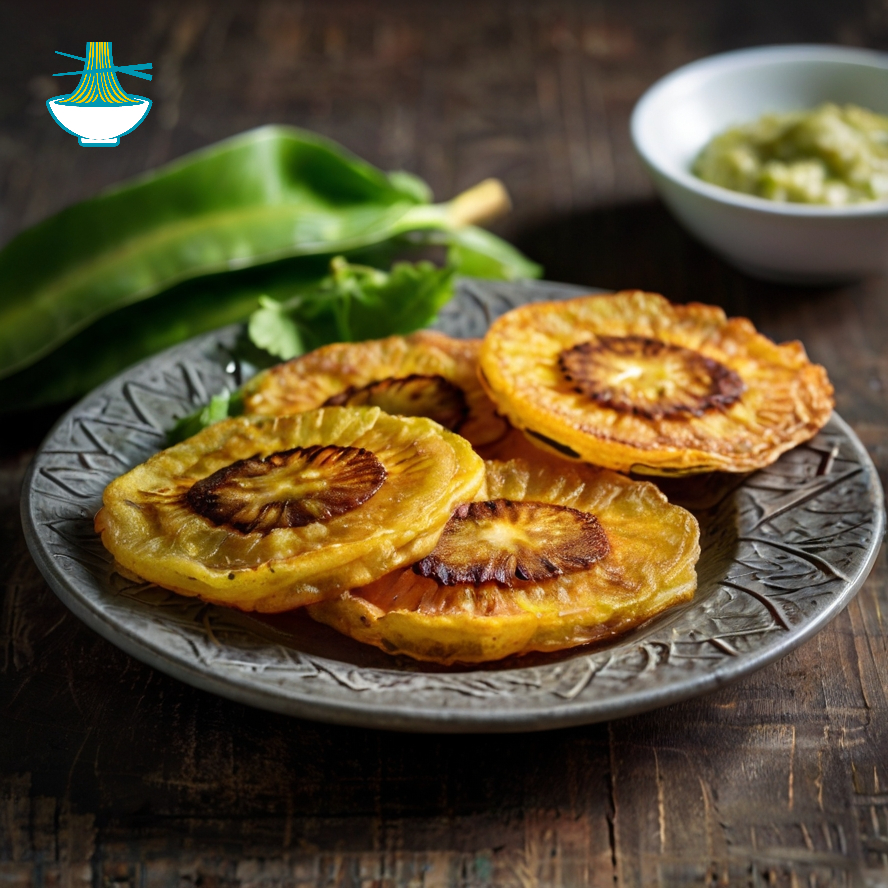Tostones, also known as Chatinos, are a beloved snack or side dish found across Latin America, particularly in Cuba, Puerto Rico, and the Dominican Republic. These crispy green plantain slices offer a delightful contrast of textures: a crunchy exterior and a tender interior. Tostones are typically enjoyed with a variety of dips and seasonings, making them a versatile addition to any meal.

Green plantains are not only delicious but also nutritious. They are a great source of vitamins A, C, and B6, as well as potassium and dietary fiber. With their low fat and cholesterol content, tostones can be a healthier alternative to many fried snacks when consumed in moderation.
Ingredients:
- 1 green plantain
- Oil for frying (vegetable oil recommended)
- Salt to taste
Instructions:
1. Select Plantains: Choose firm, green plantains with no yellow or black spots.
2. Peel Plantains: Cut off both ends of the plantain and make a shallow cut along the length. Peel off the skin using your fingers.
3. Slice Plantains: Cut the plantains into ½-inch thick slices.
4. Heat Oil: In a frying pan, heat oil over medium-high heat.
5. First Fry: Fry plantain slices for 2-3 minutes per side until golden brown. Remove and drain on paper towels.
6. Flatten Slices: Use a tostonera or a flat object to press the fried slices until about ¼-inch thick.
7. Second Fry: Return the flattened slices to the pan and fry for an additional 2-3 minutes per side, or until crispy and golden brown.
8. Season: Remove from the pan and sprinkle with salt.
9. Serve: Enjoy hot with salsa, guacamole, or your favorite dip.

Notes:
- Use firm, green plantains to ensure the best texture.
- Handle hot oil with care to avoid splatters.
- If you don’t have a tostonera, press the slices between parchment paper with a heavy object.
- Tostones can be made ahead and reheated in the oven to restore crispiness.
This delicious snack is a testament to the rich culinary traditions of Latin America and is sure to be a hit at any gathering!
Nutrition Value:
1. Green Plantain
- Calories: Approximately 122 per 100 grams
- Carbohydrates: About 31 grams per 100 grams
- Protein: Around 1.3 grams per 100 grams
- Fat: Approximately 0.3 grams per 100 grams
- Sodium: Minimal, typically negligible
- Cholesterol: None
- Vitamins: Rich in vitamins A, C, and B6
- Minerals: Good source of potassium and magnesium
Nutritional Benefit: Green plantains are a nutrient-dense food, providing essential vitamins and minerals. They are high in complex carbohydrates and fiber, which support digestive health and sustained energy levels. The high potassium content helps maintain healthy blood pressure levels.
2. Oil for Frying (Vegetable Oil Recommended)
- Calories: About 120 per tablespoon
- Carbohydrates: None
- Protein: None
- Fat: Approximately 14 grams per tablespoon
- Sodium: Minimal, typically negligible
- Cholesterol: None
- Vitamins: May contain small amounts of vitamin E, depending on the type of oil
- Minerals: Minimal, typically negligible
Nutritional Benefit: Vegetable oil provides the necessary fat for frying and contributes to the overall texture and flavor of the tostones. While it adds calories, choosing oils with healthier fat profiles can support heart health when used in moderation.
3. Salt
- Calories: None
- Carbohydrates: None
- Protein: None
- Fat: None
- Sodium: About 2,300 milligrams per teaspoon
- Cholesterol: None
- Vitamins: None
- Minerals: Sodium
Nutritional Benefit: Salt enhances the flavor of tostones but should be used in moderation to avoid excessive sodium intake. Sodium is essential for maintaining fluid balance and nerve function, but too much can lead to high blood pressure and other health issues.


Comments